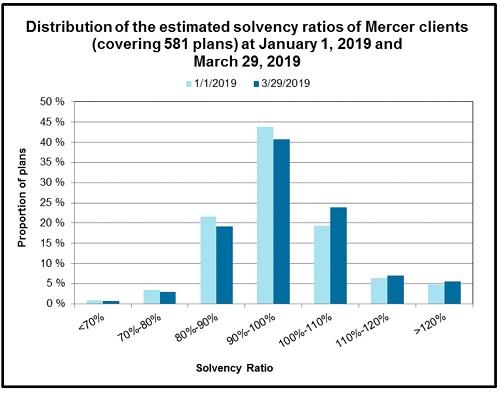Mercer says solvency has improved through the first quarter

December wasn’t good for Canada’s defined benefit pension plans and managers began 2019 with caution.
But things have improved during the first quarter and the solvency position of plans has climbed quickly to reverse most of the damage done in December.
Mercer’s Pension Health Index (based on a hypothetical plan) stood at 106% on March 31st up from 102% at the beginning of the year.
“Canadian pension plans entered 2019 with trepidation, but quickly breathed a sigh of relief by the end of the first quarter,” said Andrew Whale, Principal in Mercer Canada’s Financial Strategy Group.
The median solvency ratio of the pension plans of Mercer clients was at 97% by the end of Q1, 2019, up from 95% at the end of 2018; and almost half of Canadian pension plans is fully funded with fewer than 5% now below 80% funded on a solvency basis.
Equities boosted plans
The better solvency position of DB plans is the result of the equities rally globally, although this was offset to some degree by a 30 basis point decline in long-term interest rates.
A typical balanced pension portfolio would have risen by 9.0% during the first quarter of 2019. Equity markets rose significantly while Canadian bonds also rose.
“Although global financial markets are more settled than they were in the fourth quarter, investors still remain wary amid slowing economic growth in the global economy,” said Todd Nelson, Partner at Mercer Canada. “This economic softening combined with political uncertainty saw central banks slow their tightening path from 2018.”

Risky business
Funds pulled back on risk management activity at the end of 2018 and the cost of reducing risk increased.
But some plans are taking advantage of current conditions and sustained high activity in the Canadian annuity market led to an estimated $1.0 billion of liabilities transferred to insurance companies in 2019 so far, matching the first quarter record set last year.
“Although many pension plans ended Q1 2019 at or close to a fully funded state, the volatility over the last few months has spooked plan sponsors and served as a reminder of how fleeting a fully funded position can be,” said Whale. “Rather than sit tight, many view the sudden drop and immediate recovery as a catalyst to take action and right-size the risk held in the plan.”
Although there are potential headwinds including elections, trade agreements, and international relations, Whale highlights recent funding legislation changes in Ontario and Quebec.
“The recent relaxing of solvency-based funding in Ontario and Quebec is a gift to plan sponsors, as it provides flexibility and protects against year-over-year volatility,” he said. “On the other hand, it forces plan sponsors to be proactive in setting funding policy. Funding the bare minimum will no longer get plans with short to medium time horizons to their desired destination.”



